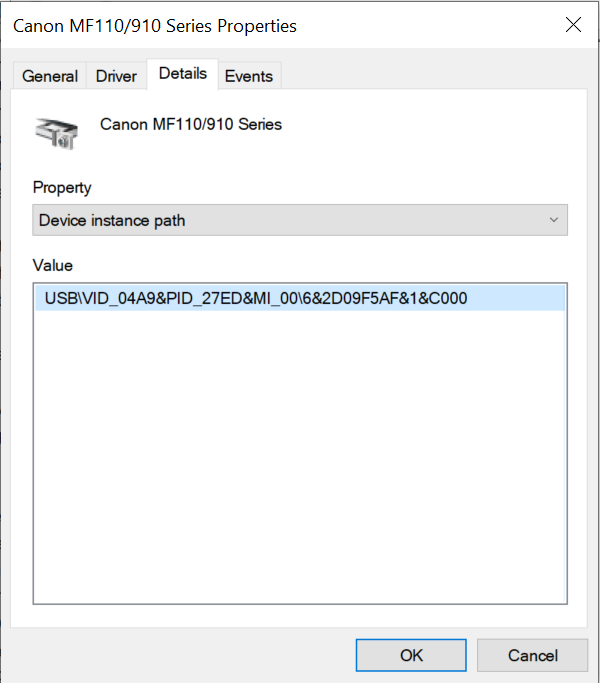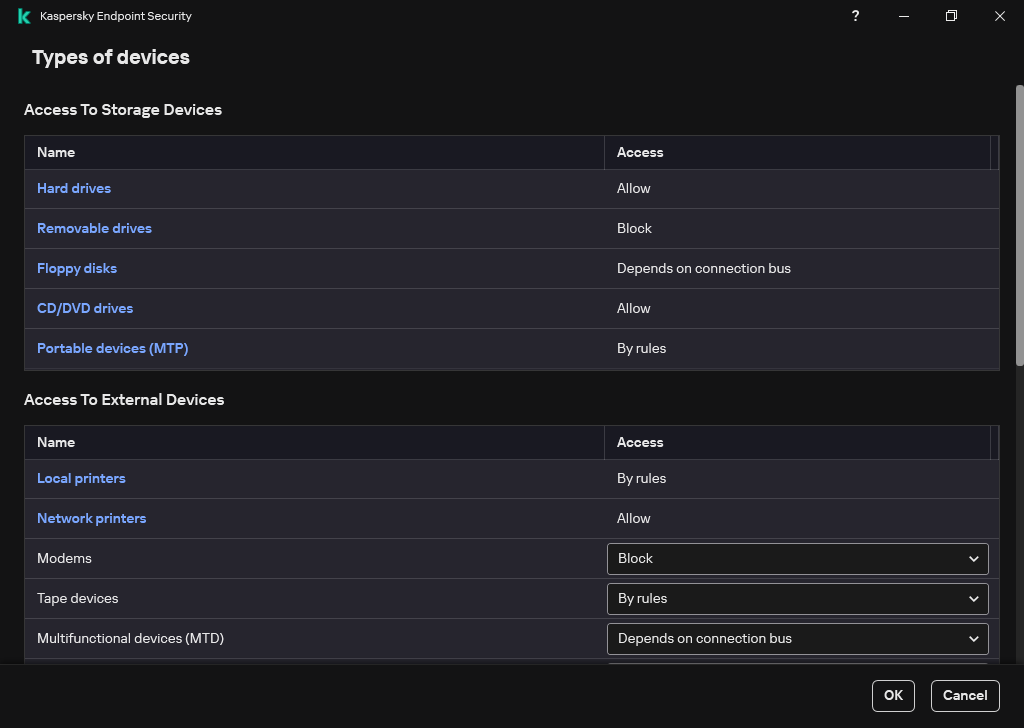Control of printing
You can use Control of printing to configure user access to local and network printers.
Local printer control
Kaspersky Endpoint Security allows configuring access to local printers on two levels: connecting and printing.
Kaspersky Endpoint Security controls local printer connection over the following buses: USB, Serial Port (COM), Parallel Port (LPT).
Kaspersky Endpoint Security controls the connection of local printers to COM and LPT ports only on the level of the bus. That is, to prevent the connection of printers to COM and LPT ports, you must prohibit the connection of all device types to COM and LPT buses. For printers connected to USB, the application exercises control on two levels: device type (local printers) and connection bus (USB). Therefore you can allow all device types except local printers to connect to USB.
You can select one of the following access modes to local printers via USB:
- Allow
 . Kaspersky Endpoint Security grants full access to local printers to all users. Users can connect printers and print documents using the means that the operating system provides.
. Kaspersky Endpoint Security grants full access to local printers to all users. Users can connect printers and print documents using the means that the operating system provides. - Block
 . Kaspersky Endpoint Security blocks the connection of local printers. The application allows connecting only trusted printers.
. Kaspersky Endpoint Security blocks the connection of local printers. The application allows connecting only trusted printers. - Depends on connection bus
 . Kaspersky Endpoint Security allows connecting to local printers in accordance with the USB bus connection status (Allow
. Kaspersky Endpoint Security allows connecting to local printers in accordance with the USB bus connection status (Allow  or Block
or Block  ).
). - By rules
 . To control printing, you must add printing rules. In the rules, you can select users or a group of users for which you want to allow or block access to printing documents on local printers.
. To control printing, you must add printing rules. In the rules, you can select users or a group of users for which you want to allow or block access to printing documents on local printers.
Network printer control
Kaspersky Endpoint Security allows configuring access to printing on network printers. You can select one of the following access modes to network printers:
- Allow and do not log
 . Kaspersky Endpoint Security does not control printing on network printers. The application grants access to printing to all users and does not save information about printing to the event log.
. Kaspersky Endpoint Security does not control printing on network printers. The application grants access to printing to all users and does not save information about printing to the event log. - Allow
 . Kaspersky Endpoint Security grants access to printing on network printers to all users.
. Kaspersky Endpoint Security grants access to printing on network printers to all users. - Block
 . Kaspersky Endpoint Security restricts access to network printers for all users. The application allows access only to trusted printers.
. Kaspersky Endpoint Security restricts access to network printers for all users. The application allows access only to trusted printers. - By rules
 . Kaspersky Endpoint Security grants access to printing in accordance with printing rules. In the rules, you can select users or a group of users that will be allowed or prevented from printing documents on network printer.
. Kaspersky Endpoint Security grants access to printing in accordance with printing rules. In the rules, you can select users or a group of users that will be allowed or prevented from printing documents on network printer.
Adding printing rules for printers
How to add printing rules in the Administration Console (MMC)
How to add printing rules in Web Console and Cloud Console
How to add printing rules in the application interface
Trusted printers
Trusted devices are devices to which users that are specified in the trusted device settings have full access at all times.
The procedure for adding trusted printers is exactly the same as for other types of trusted devices. You can add local printers by ID or device model. You can only add network printers by device ID.
To add a trusted local printer by ID, you will need a unique ID (Hardware ID – HWID). You can find the ID in device properties by using operating system tools (see figure below). The Device Manager tool lets you do this. The ID of a local printer may look like this: 6&2D09F5AF&1&C000. Adding devices by ID is convenient if you want to add several specific devices. You can also use masks.
To add a trusted local printer by device model, you will need its Vendor ID (VID) and Product ID (PID). You can find the IDs in device properties by using operating system tools (see figure below). Template for entering the VID and PID: VID_04A9&PID_27FD. Adding devices by model is convenient if you use devices of a certain model in your organization. This way, you can add all devices of this model.

Device ID in Device Manager
To add a trusted network printer, you will need its device ID. For network printers, the device ID can be the network name of the printer (name of the shared printer), the IP address of the printer, or the URL of the printer.

